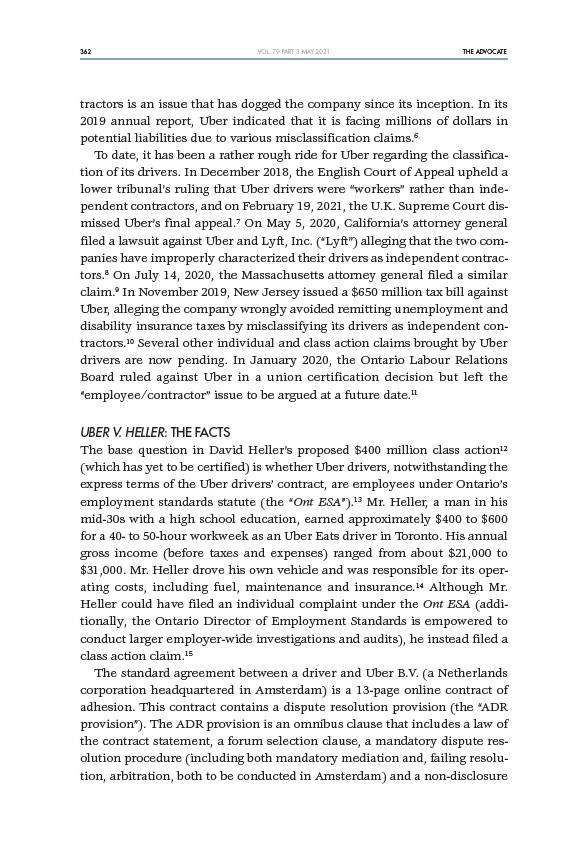
362 THE ADVOCATE
VOL. 79 PART 3 MAY 2021
tractors is an issue that has dogged the company since its inception. In its
2019 annual report, Uber indicated that it is facing millions of dollars in
potential liabilities due to various misclassification claims.6
To date, it has been a rather rough ride for Uber regarding the classification
of its drivers. In December 2018, the English Court of Appeal upheld a
lower tribunal’s ruling that Uber drivers were “workers” rather than independent
contractors, and on February 19, 2021, the U.K. Supreme Court dismissed
Uber’s final appeal.7 On May 5, 2020, California’s attorney general
filed a lawsuit against Uber and Lyft, Inc. (“Lyft”) alleging that the two companies
have improperly characterized their drivers as independent contractors.
8 On July 14, 2020, the Massachusetts attorney general filed a similar
claim.9 In November 2019, New Jersey issued a $650 million tax bill against
Uber, alleging the company wrongly avoided remitting unemployment and
disability insurance taxes by misclassifying its drivers as independent contractors.
10 Several other individual and class action claims brought by Uber
drivers are now pending. In January 2020, the Ontario Labour Relations
Board ruled against Uber in a union certification decision but left the
“employee/contractor” issue to be argued at a future date.11
UBER V. HELLER: THE FACTS
The base question in David Heller’s proposed $400 million class action12
(which has yet to be certified) is whether Uber drivers, notwithstanding the
express terms of the Uber drivers’ contract, are employees under Ontario’s
employment standards statute (the “Ont ESA”).13 Mr. Heller, a man in his
mid-30s with a high school education, earned approximately $400 to $600
for a 40- to 50-hour workweek as an Uber Eats driver in Toronto. His annual
gross income (before taxes and expenses) ranged from about $21,000 to
$31,000. Mr. Heller drove his own vehicle and was responsible for its operating
costs, including fuel, maintenance and insurance.14 Although Mr.
Heller could have filed an individual complaint under the Ont ESA (additionally,
the Ontario Director of Employment Standards is empowered to
conduct larger employer-wide investigations and audits), he instead filed a
class action claim.15
The standard agreement between a driver and Uber B.V. (a Netherlands
corporation headquartered in Amsterdam) is a 13-page online contract of
adhesion. This contract contains a dispute resolution provision (the “ADR
provision”). The ADR provision is an omnibus clause that includes a law of
the contract statement, a forum selection clause, a mandatory dispute resolution
procedure (including both mandatory mediation and, failing resolution,
arbitration, both to be conducted in Amsterdam) and a non-disclosure